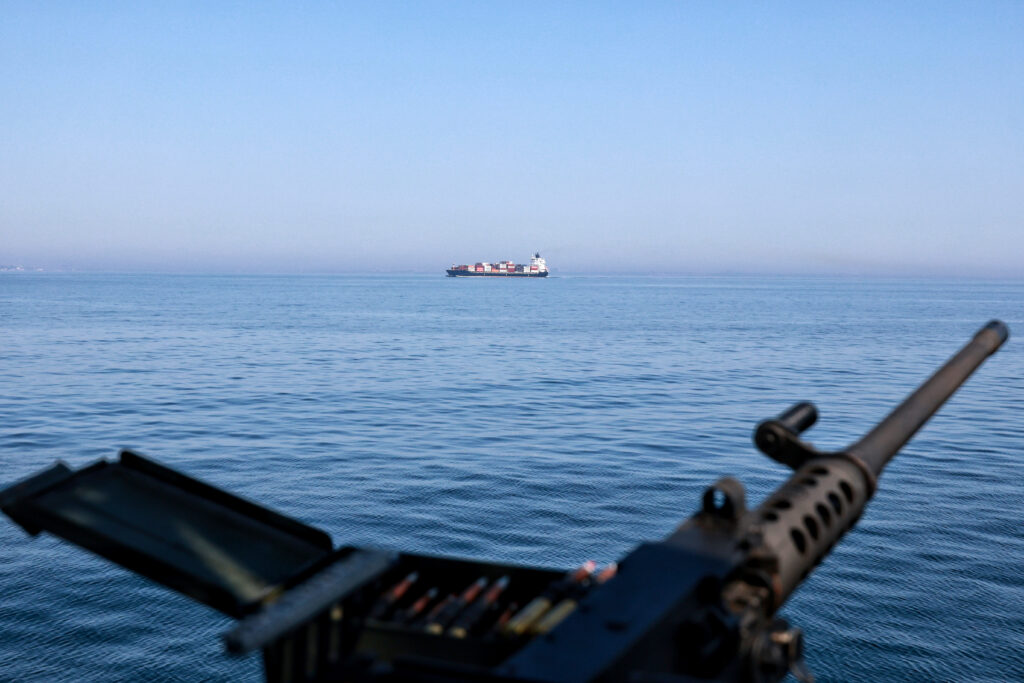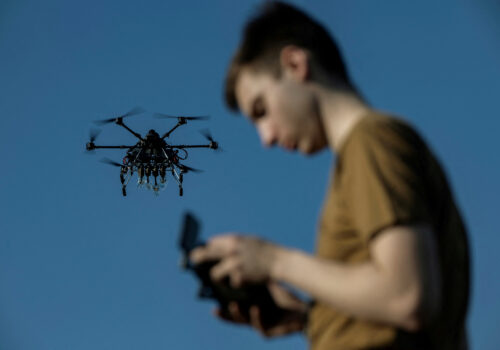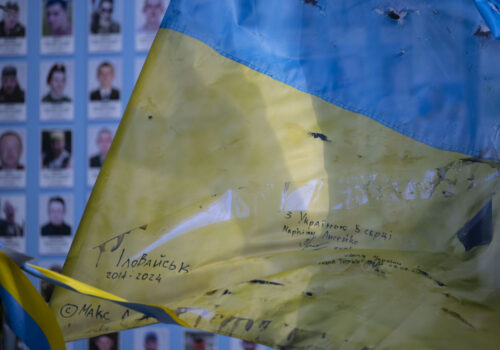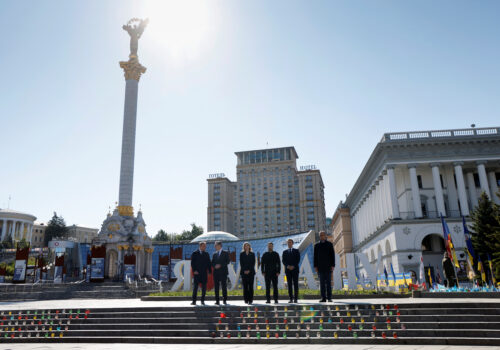As the Russian army continues to wage a brutal war of attrition in Ukraine, the two nations are also locked in an economic contest that could play a key role in determining the outcome of Europe’s largest invasion since World War II.
A little noticed fact is that the Ukrainian economy is actually doing relatively well in the context of the current war. The Russian onslaught in 2022 reduced Ukraine’s GDP by 29 percent, but in 2023 it recovered by an impressive 5.5 percent. Last year, Ukrainian GDP rose by a further 3 percent, though growth is likely to slow to 1.5 percent this year.
Any visitor to Ukraine can take out cash from an ATM or pay in shops using an international credit card. Countries embroiled in major wars typically experience price controls, shortages of goods, and rationing, but Ukraine has none of these. Instead, stores are fully stocked and restaurants are crowded. Everything works as usual.
How has this been possible? The main answer is that Ukraine’s state institutions are far stronger than anybody anticipated. This is particularly true of the ministry of finance, the National Bank of Ukraine, and the state fiscal service. After 2022, Ukraine’s state revenues have risen sharply.
In parallel, wartime Ukraine has continued to make progress in combating corruption. When Russia’s invasion of Ukraine first began in 2014, Ukraine was ranked 142 of 180 countries in Transparency International’s annual Corruption Perceptions Index. In the most recent edition, Ukraine had climbed to the 105 position.
Rising Ukrainian patriotism has helped fuel this progress in the fight against corruption. EU accession demands and IMF conditions have been equally important. Ukraine has gone through eight quarterly reviews of its four-year IMF program. It has done so on time and with flying colors. The same has been true of each EU assessment.
Stay updated
As the world watches the Russian invasion of Ukraine unfold, UkraineAlert delivers the best Atlantic Council expert insight and analysis on Ukraine twice a week directly to your inbox.
Looking ahead, three critical factors are necessary for wartime Ukraine’s future economic progress. First of all, Ukraine needs about $42 billion a year in external budget financing, or just over 20 percent of annual GDP, to finance its budget deficit. The country did not receive sufficient financing in 2022 because EU partners failed to deliver promised sums. This drove up Ukraine’s inflation rate to 27 percent at the end of 2022. The Ukrainian budget was fully financed in 2023 and 2024, driving down inflation to 5 percent. The budget will be fully financed this year.
The second factor is maritime trade via Ukraine’s Black Sea ports. Shipping from Odesa and neighboring Ukrainian ports to global markets has been almost unimpeded since September 2023 after Ukraine took out much of the Russian Black Sea Fleet. The vast majority of Ukraine’s exports are commodities such as agricultural goods, steel, and iron ore, which are only profitable with cheap naval transportation, so keeping sea lanes open is vital.
The third crucial factor for wartime Ukraine’s economic prospects is a steady supply of electricity. Russian bombing of Ukraine’s civilian energy infrastructure disrupted the power supply significantly in 2024, which was one of the main reasons for the country’s deteriorating economic performance.
Ukraine’s economic position looks set to worsen this year. In the first four months of 2025, economic growth was only 1.1 percent, while inflation had risen to 15.9 percent by May. The main cause of rising inflation is a shortage of labor. The national bank will presumably need to hike its current interest rate of 15.5 percent, which will further depress growth. After three years of war, Ukraine’s economy is showing increasing signs of exhaustion. The country has entered stagflation, which is to be expected.
Eurasia Center events

Russia’s current economic situation is surprisingly similar to Ukraine’s, although almost all trade between Russia and Ukraine has ceased. After two years of around 4 percent economic growth in 2023 and 2024, Russia is expecting growth of merely 1.5 percent this year, while official inflation is 10 percent. Since October 2024, the Central Bank of Russia has maintained an interest rate of 21 percent while complaining about stagflation.
The Russian and Ukrainian economies are both suffering from their extreme focus on the military sector. Including Western support, Ukraine’s military expenditure amounts to about $100 billion a year, which is no less than 50 percent of Ukraine’s GDP, with 30 percent coming from the Ukrainian budget in 2024. Meanwhile, Russia’s 2025 military expenditure is supposed to be $170 billion or 8 percent of GDP. Unlike the Ukrainians, the Russians complain about the scale of military spending. This makes sense. The Ukrainians are fighting an existential war, while Russia’s war is only existential for Putin.
Contrary to common perceptions, Russia does not have an overwhelming advantage over Ukraine in terms of military expenditure or supplies. Russia does spend significantly more than Ukraine, but much of this is in reality stolen by politicians, generals, and Putin’s friends. Furthermore, Western sanctions impede the Russian military’s ability to innovate. In contrast, Ukraine benefits from innovation because its economy is so much freer, with hundreds of startups thriving in areas such as drone production.
Russia is now entering a fiscal crunch. Its federal expenditures in 2024 amounted to 20 percent of GDP and are likely to stay at that level in 2025, of which 41 percent goes to military and security. However, the Kremlin has financed its budget deficit of about 2 percent of GDP with its national welfare fund, which is expected to run out by the end of the current year. As a result, Russia will likely be forced to reduce its public expenditures by one-tenth.
Low oil prices could add considerably to Russia’s mounting economic woes and force a further reduction in the country’s public expenditures. However, Israel’s attack on Iran may now help Putin to stay financially afloat by driving the price of oil higher.
Economically, this is a balanced war of attrition at present. Ukraine’s Western partners have the potential to turn the tables on Russia if they choose to do so. Ukraine has successfully built up a major innovative arms industry. What is missing is not arms but funds. The West needs to double Ukraine’s military budget from today’s annual total of $100 billion to $200 billion. They can do this without using their own funds if they agree to seize approximately $200 billion in frozen Russian assets currently held in Euroclear Bank in Belgium. This could enable Ukraine to outspend Russia and achieve victory through a combination of more firepower, greater technology, and superior morale.
Anders Åslund is the author of “Russia’s Crony Capitalism: The Path from Market Economy to Kleptocracy.”
Further reading
The views expressed in UkraineAlert are solely those of the authors and do not necessarily reflect the views of the Atlantic Council, its staff, or its supporters.

The Eurasia Center’s mission is to enhance transatlantic cooperation in promoting stability, democratic values, and prosperity in Eurasia, from Eastern Europe and Turkey in the West to the Caucasus, Russia, and Central Asia in the East.
Follow us on social media
and support our work
Image: A container ship sails past a Ukrainian Navy cutter equipped with a machine gun while on patrol in the Black Sea along the coast of Odesa, Ukraine, on April 17, 2025. (Photo by Nina Liashonok/Ukrinform)





